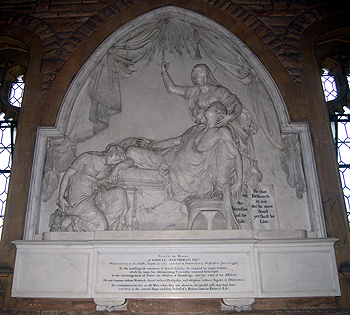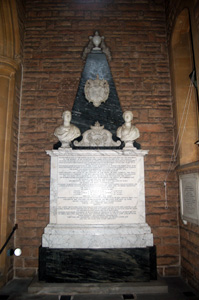
The memorial to Samuel Whitbread I May 2010
The Whitbread family is famously associated with Southill, having its seat at Southill Park. However, the family also has an estate in Cardington and some members of the family are buried in Cardington church. The family can be traced as early as 1314 in the county when John Whytbred was an elector in the Biggleswade Hundred and Richard Whytbred in the Flitt Hundred.
A memorial by Ive Whitbread to his ancestors in Cardington Church reads as follows: "Ive Whitbread , esquire of this parish and of the City of London, merchant, erected this monument to the memory of his ancestors who, coming into England with the Normans, settled at Ion House in the parish of Upper Gravenhurst in this County of Bedford upon an estate given them by the Conqueror and continued there until the year 1630 when William Whitbread, esquire, purchased lands and settled in this town of Cardington where the family have ever since continued and many of them upon their decease have been interred in this church".
"His eldest son Henry Whitbread, esquire, who espoused the cause of his country in the reign of King Charles the First, and accepting of a commission in the army, behaved with the greatest courage and gallantry and was many years Receiver General and Justice of the Peace for this county. He married Lettice, daughter of Edward Leeds of Croxton in the County of Cambridge, esquire, by whom he had two sons and six daughters. She died 4 June 1698, aged 69 years. He died 4 August 1701 aged 74 years".
"His eldest son Henry Whitbread, esquire succeeded to his estates and office of Receiver General and first married Sarah, daughter and co-heiress of John Ive of London, merchant and had by her three sons and three daughters. She died 27 December 1710 aged 36 years. He died 13 October 1727 aged 62 years".
"Sarah died 10 March 1699 aged 11 months. William died 16 July 1721 aged 28 years. Lettice died 21 december 1721 aged 25 years".
"He married to his second wife Elizabeth, daughter of Phillip Read of New Sarum in Wilts, M. D. and had by her two sons and one daughter. She died 9 January 1746, aged 59 years. Henry, the eldest son, died 22 April 1742, aged 22 years. Samuel and Elizabeth are living MDCCL [1750]".
"The above mentioned John Whitbread, esquire, died a bachelor 12 February 1762, aged 67 years. Rachel married Oliver Edwards, esquire, of the City of London and died 29 August 1757, aged 66 years".
"Ive Whitbread esquire, above and first mentioned married Elizabeth, daughter of Peter Hinde of Theobalds in the County of Hertford, esquire. He died 17 May 1765, aged 65 years, she survived him only to 7 July 1766, aged 46 years. Their remains are interred underneath. They had one daughter, Catherine, who died an infant 13 June 1748 and one son Jacob now living MDCCLXVI [1766]".

The memorial by Ive Whitbread May 2010
The family was in Gravenhurst in 1639 and it was then, despite what Ive's monument says, that William Whitbread and his son Henry sold the Manor of Ion [W3150] and in the same year began to buy property in Cardington [W263-266]. Samuel Whitbread I was born in Cardington in 1720 and went on to found a brewery in London. This grew to become a nationwide brewing business before the company divested itself of all its breweries and licensed houses in 2002 to concentrate on hotels, restaurants and coffee shops. Samuel bought Cardington Manor in 1769. The Manor of Fenlake Barns was purchased in 1779 and the lesser Cardington Manor was purchased a hundred years later in 1879.
The great prison reformer and philanthropist John Howard also had an estate in Cardington, begun by his father, and bought Howard House in 1757. He also acquired other property in the parish [W517-833].
John Byng, 5th Viscount Torrington, remarked in his diary that the friendly rivalry between the two major landowners was a benefit to the village, Cardington was: “a Village of much Neatness, with all Houses so smart, and the Green so nicely planted … This Church and the Church yard … are in the best conservation; for Messrs Whitbread and Howard being at variance (luckily for the Village) strive which shall most benefit and adorn it: consequently the Cottages are neat and comfortable; For what cannot the Riches of the one, and the Charity of the other, accomplish?” Howard’s Cardington estate came to Samuel Charles Whitbread in 1823 after the deaths of Howard and his son. It then became part of the main Whitbread Estate when Samuel Charles succeeded his brother William Henry as head of the family.